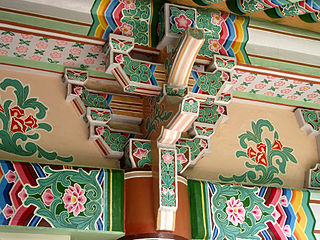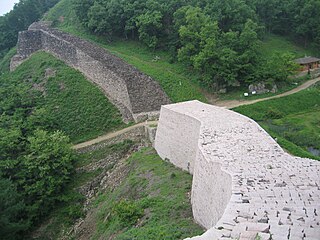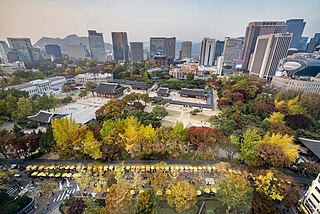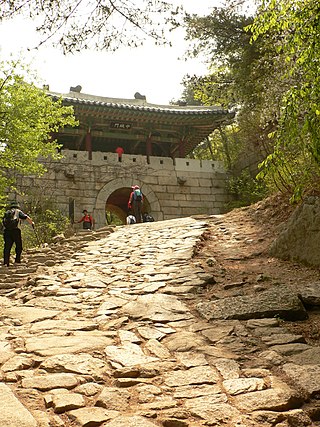
Goguryeo also later known as Goryeo, was a Korean kingdom which was located on the northern and central parts of the Korean Peninsula and the southern and central parts of modern-day Northeast China (Manchuria). At its peak of power, Goguryeo conquered most of the Korean Peninsula and large parts of Manchuria, along with parts of eastern Mongolia, Inner Mongolia, and modern-day Russia.

The Three Kingdoms of Korea or Samguk competed for hegemony over the Korean Peninsula during the ancient period of Korean history. During the Three Kingdoms period, many states and statelets consolidated until, after Buyeo was annexed in 494 and Gaya was annexed in 562, only three remained on the Korean Peninsula: Goguryeo, Baekje and Silla. The "Korean Three Kingdoms" contributed to what would become Korea; and the Goguryeo, Baekje and Silla peoples became the Korean people.

Cheongju is the capital and largest city of North Chungcheong Province in South Korea.

Goguryeo tombs, officially designated as the Complex of Koguryo Tombs, are tombs in North Korea. In July 2004, they became the first UNESCO World Heritage site in the country. The site consists of 30 individual tombs from the later Goguryeo kingdom, one of Three Kingdoms of Korea, located in the cities of P'yŏngyang and Namp'o. Goguryeo was one of the strongest ancient Korean kingdoms located in the northern and central parts of the Korean Peninsula and the southern and central parts of Manchuria. The kingdom was founded in the present day area of North Korea, and part of Manchuria around 37 BCE, and the capital was transferred to P'yŏngyang in 427 CE.

Namhansanseong (Korean: 남한산성) is a historical mountain fortress city 25 km southeast of Seoul, South Korea. It sits approximately 480 m above sea level and is aligned with the ridges of the mountain for maximum defensibility. The fortress, stretching 12 km in length, protects a vast area used as an emergency capital city during the Joseon Dynasty of Korea (1392–1910). The design is based on fortress architecture of East Asia, embodying aspects of four historical cultural styles: the Joseon of Korea, the Azuchi-Momoyama Period of Japan, and Ming and Qing China.

Goyang is a city in Gyeonggi Province in the north of South Korea. It is part of the Seoul Capital Area, making Goyang one of Seoul's satellite cities. It is one of the largest cities in the Seoul Capital Area, with a population of just over 1 million. Ilsan, a planned city, is located in the Ilsandong-gu and Ilsanseo-gu districts of Goyang. It also includes Deogyang-gu which is closer to Seoul.

Mahan was a loose confederacy of statelets that existed from around the 1st century BC to 6th century AD in the southern Korean peninsula in the Chungcheong and Jeolla provinces. Arising out of the confluence of Gojoseon migration and the Jin state federation, Mahan was one of the Samhan, along with Byeonhan and Jinhan. Baekje began as a member statelet, but later overtook all of Mahan and became one of the Three Kingdoms of Korea.
Gaero of Baekje was the 21st king of Baekje, one of the Three Kingdoms of Korea. He was the eldest son of the 20th king Biyu. He died in battle as Baekje's capital in the present-day Seoul region fell to the northern rival kingdom Goguryeo.

Korean architecture refers to an architectural style that developed over centuries in Korea. Throughout the history of Korea, various kingdoms and royal dynasties have developed a unique style of architecture with influences from Buddhism and Korean Confucianism.

Tourism in South Korea and its industry caters to both foreign and domestic tourists. In 2019, 17.5 million foreign tourists visited South Korea, making it the 20th most visited country in the world. Most non-Korean tourists come from other parts of East Asia such as Japan, mainland China, Taiwan, and Hong Kong. The recent popularity of Korean popular culture, often known as the "Korean Wave", in these countries has increased tourist arrivals.

Samnyeon Sanseong Fortress is the ruins of a Silla fortress and wall that was built beginning in the year 470. The fortress was reconstructed in 486. The ruins are located in present-day Boeun, South Korea. During the Three Kingdoms Period the town of Boeun-eup, located two kilometers from the fortress, was known as Samnyeon-gun or Samnyeonsan-gun and it is believed by some that the fortress gets its name from the town. However, the Samguk Sagi relates that the fortress was completed in three years, and that the fortress derived its name from this fact. This account also suggests that the nearby town derived its name from the fortress, rather than vice versa. The Annals of Joseon Dynasty show that the fortress was known as Ojeong Sanseong Fortress and was used during the Joseon Dynasty, probably because the fortress is located atop Mount Ojeongsan.

Gungnaeseong or Guonei was the capital of the ancient Korean kingdom of Goguryeo, which was located in Manchuria and the Korean Peninsula. The perimeter of its outer fortress measures 2,686m. It is located in present day Ji'an city, Jilin province, northeast China. Because of its historical importance and exceptional architecture, Gungnae was designated as a UNESCO World Heritage Site in 2004. It is part of the Capital Cities and Tombs of the Ancient Koguryo Kingdom World Heritage Site, together with nearby Hwando Mountain City and the Onyeosan City, in modern northeast China.

The Capital Cities and Tombs of the Ancient Koguryo Kingdom is an UNESCO World Heritage Site which includes a number of archaeological sites currently in Ji'an, Jilin Province and Huanren, Liaoning Province in Northeast China. Goguryeo, was a Korean Kingdom located in the northern and central parts of the Korean Peninsula and the southern and central parts of Manchuria.

Wunü Shan, which means "mountain of Five Women", is a mountain of historical and cultural significance located in the north of the Huanren Town, in Huanren Manchu Autonomous County, Liaoning province, China. It is located northwest of the Hun Jiang River. The tallest peak is the 821 metre-high Main Peak, measuring 1,500 metres long and 300 metres wide.

Seoul, officially Seoul Special City, is the capital of the Republic of Korea (ROK), commonly known as South Korea, and the country's most populous urban area. The broader Seoul Capital Area, encompassing Gyeonggi province and Incheon metropolitan city, emerged as the world's fourth largest metropolitan economy in 2014, trailing only Tokyo, New York City, and Los Angeles, hosting more than half of South Korea's population. Although Seoul's population peaked at slightly over 10 million, it has gradually decreased since 2014, standing at approximately 9.97 million residents as of 2020. Seoul is the seat of the South Korean government.

The Bukhansanseong is a fortress located in Gyeonggi Province and Seoul, South Korea, dating back to the middle Joseon period. The present fort was completed in 1711, though plans for the structure date back to 1659. The name is also given to a fortress mentioned in the Samguk Sagi, constructed by Gaeru of Baekje in 132 CE, and the two are often conflated although the putative connection is contested.
The following is a timeline of the history of the city of Seoul, South Korea.

The Baekje Historic Areas are a group of monuments located in three South Korean cities: Gongju, Buyeo, and Iksan. They relate to the last period of the Baekje Kingdom, representing the period from 475 to 660 CE, which was one of the three kingdoms that flourished from 18 BC to 660 CE. The property designated as a UNESCO World Heritage Site has eight archaeological sites. These are: The Gongsanseong fortress and the royal tombs at Songsan-ri, related to the capital city of Ungjin, now Gongju; the Busosanseong Fortress and Gwanbuk-ri administrative buildings, the Jeongnimsa Temple, the Neungsan-ri royal tombs, and the Naseong city wall in Sabi, now Buyeo; and the Wanggung-ri Palace and the Mireuksa Temple in Iksan, a subsidiary capital region of Sabi.






















